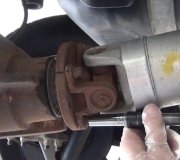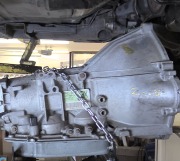There are 2 components that you can test manually with a multi-meter.
The first is the Clutch Pressure Control Solenoid Valve, "A" and "B". It is located on the 2.3L, it is located on the right side of the transaxle right by to tab used to hook an engine hoist to remove the engine/tranny assembly. On the 3.0L, it is on the top rear or transaxle. The A and B solenoids are on top of each other. They have 2 pin connectors with "A" having a red wire in connection, "1" and a white wire in connection, "2". The B connector has an orange wire in the, "1" connection and green in the, "2" connection.
To test solenoid;
1. Disconnect harness
2. Measure resistance before terminals. It should be 5 Ohms, if it is not solenoid needs replacement.
3. To check solenoid movement, apply 12V to terminal, "1" and ground, "2". Clicking noise indicates solenoid works.
4. Remove solenoid to check fluid passage for debris/clogging. If debris is removed, repeat step 3. To ensure solenoid still moves properly.
The second component is the Lock-up solenoids. They are located on the right front of engine compartment of 2.3L and the Top front of the 3.0L The wires are either Blue/yellow or yellow from the connector in either terminal.
1. Disconnect harness and measure resistance between terminal, "1' and ground. It should be 12-25 Ohms. Replace solenoid is of of specified range.
2. Ensure solenoid movement by grounding body of solenoid to ground and 12V to terminal, "1" and then terminal, "2". Both should make a clicking noise if solenoid is operating.
Check these solenoids and scan trouble codes then let me know results.
SPONSORED LINKS
Tuesday, July 7th, 2020 AT 2:18 PM
(Merged)



